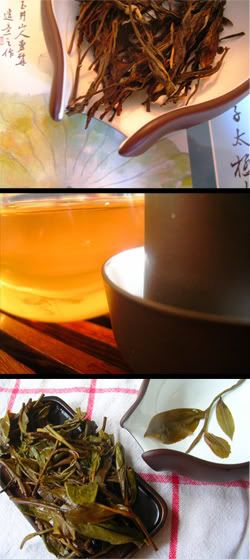Caledonian Springs @ 100C in 12cl shengpu pot; ~7-8g leaf; 1 rinse
 Dry leaf:
Dry leaf:On snipping off a corner of the sealed foil bag in which this sample arrived, the unmistakable fruity aroma of maofeng escapes - is this a "green tea" pu'er? This maocha is serious in size, being 7-8cm stems with one or two leaves attached to each. Colours range from light to dark green. The maofeng aroma is distinctive, radiating from the chahe.
3s, 5s, 16s, 40s, 90s, 120s+, 180s+:
A solid yellow soup with a hint of green. The aroma is sweet shengpu, and yet the maofeng character is present in the wenxiangbei. It fades to a lengxiang of brown sugar, which for some reason I have taken to being a good sign - many of the poorer teas I've come across seem to be devoid of any lengxiang.
The tea itself is interesting: it has an oily smoothness that I usually associate with good leaves. The flavour is gentle, reminiscent of the oft-encountered set of straw tastes.
Despite attempts to overbrew this tea, there is no ku in it whatsoever. The flavour is fairly muted, but pleasant enough. Of interest is a fair huigan, which rises like a crescendo in the throat. Given the usual potency of banzhang leaves, I am surprised that this has no ku at all.
Wet leaf:
Outrageously beautiful. I love to look at good maocha, and this certainly is pretty: young, healthy, and vibrant leaves with whole tip-and-bud systems are to be found.
Overall:
Fair enough, but where is the potency? This is a very gradual and drinkable tea, and I am surprised that one can find maocha (particularly banzhang maocha) that is missing its ku.
When the price-tag is brought into the equation, this doesn't deliver enough strength or variety for my personal tastes - though what it does is pleasant enough.

5 comments:
A maofeng like Banzhang? Many of this year's crop taste like green tea, but this is 2005, or so they say
I think it doesn't look too much like a Banzhang, at least not ones I've encountered that are of good provenance, from the wet leaves.
It really was remarkably maofeng, and yet only in the aroma. The flavour was fairly quiet straw-and-mushroom, as one might hope from pu'er. Wherever it hails from, it's pretty, but as you say, it may well be somewhere other than Banzhang...
Toodlepip,
Hobbes
Would you prefer a maofeng?
Hmmm interesting..the tea actually was called yun cha, but we named it mao cha, it is actually called 'yun' cha, it means totally made by the same pu erh leaves( i guess in term of size and leaves).
Mao cha has some mixed leaves maybe different ages of tea leaves. I do not know how to write the 'yun' in pin yin, it's not this 'yun' for sure. so we just classified as mao cha. any idea of such yun pu erh cha?
when you say maofeng do you mean the green tea?
-Lisa-
Dear Lisa,
I suspect it's 匀茶 [even/uniform tea], though it isn't a term I have come across before in reference to pu'er. The leaves were certainly homogenous (and pretty).
The maofeng to which I liken it is indeed the lucha - rich grape aroma and a thick, low flavour of the same.
Thanks for the extra information, and toodlepip,
Hobbes
Post a Comment